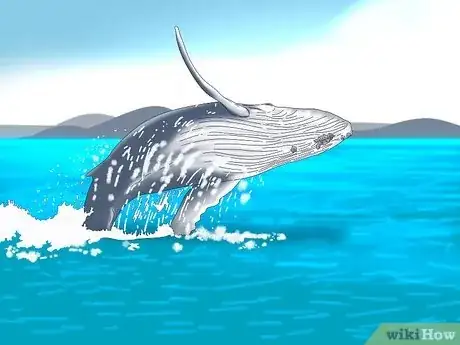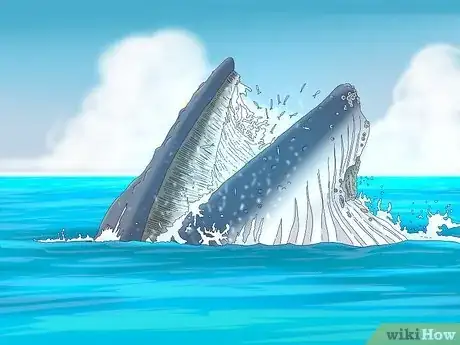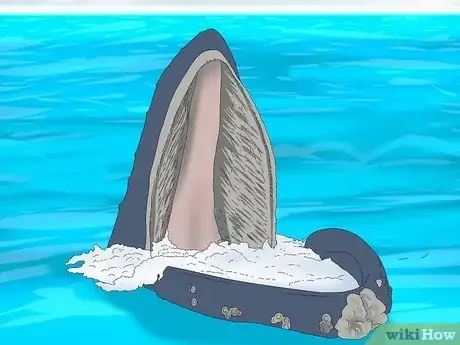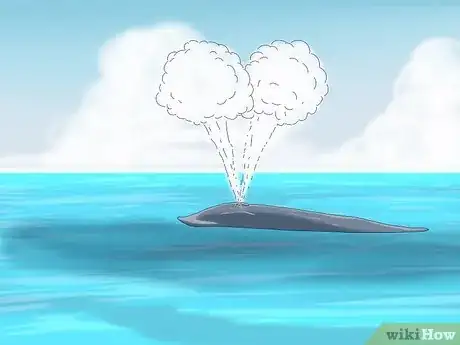This article was co-authored by wikiHow staff writer, Luke Smith, MFA. Luke Smith is a wikiHow Staff Writer. He's worked for literary agents, publishing houses, and with many authors, and his writing has been featured in a number of literary magazines. Now, Luke writes for the content team at wikiHow and hopes to help readers expand both their skillsets and the bounds of their curiosity. Luke earned his MFA from the University of Montana.
There are 11 references cited in this article, which can be found at the bottom of the page.
Learn more...
Breaching is one of nature’s most spectacular sights, and almost every type of whale does it. But why? What makes whales throw themselves out of the water only to crash right back in? The truth is that biologists can’t really be sure why, but they have a number of theories that could explain this trademark behavior. We’ll give you a simple rundown of possible explanations for whales’ airborne antics, how often they do it, and how you can spot a breaching whale yourself.
Things You Should Know
- Whales might breach to communicate, prepare for a dive, or get rid of parasites, but these are only theories among biologists.
- Whales breach at irregular intervals, but larger whales come to the surface about every 10-15 minutes.
- Spot a breaching whale by searching for waterspouts, tail fins, spyhopping, and the signature breach when whale watching.
Steps
Why Whales Breach
-
1To communicate with far-off whales. Sound travels both farther and faster underwater, and when a whale leaps and slaps back into the water, it makes quite the sound. Whales might use this to their advantage to signal far-off groups of whales, especially when the waters are windy or choppy, and there’s more “background noise.”[1]
- Whales also communicate with other, nearby whales by their trademark “singing” and by slapping their fins. These can signal a number of things, like mating availability, greetings, play, the presence of food, or to warn of predators.
-
2To prepare for a dive. Whales may jump out of the water in order to stock up on oxygen before swimming deeper into the ocean. Whales’ blood cells contain a protein called myoglobin, which carries oxygen. The physical activity involved in leaping out of the water might lead to greater amounts of myoglobin, which means more oxygen for the leaping whale, which means a deeper dive.[2]
- Whales breathe oxygen, and while they usually don’t leap out of the water to breathe (instead they merely poke their heads out), they may sometimes breach in order to quickly empty their lungs of water they accidentally inhaled.[3]
Advertisement -
3To peek above the water. Whales don’t have the best eyesight, and things are especially limited underwater. Some biologists think whales may leap out of the water to get a better look at what’s going on above the surface–to spot land formations, boats, and other activity.[4]
- Some researchers speculate that whales breach more often near boats in order to get a better look at the activity on the surface.[5]
-
4To get rid of parasites or dead skin. Whales are massive (humpback whales, the largest whale species and most notable jumper, can weigh up to 80,000 pounds (36,000 kg)!), and they produce a similarly massive amount of force when they hit the surface of the water.[6] That force could serve to knock loose any parasites or dead skin clinging to the whale.[7]
- Some people think whales might also breach to get rid of barnacles, but many whales use barnacles as armor for defense against predators and other whales.[8]
-
5To aid digestion. Biologists have recently suggested that leaping out of the water helps get food moving inside a whale. Humpback whales eat about 20,000 pounds (9,100 kg) of fish each day during feeding season, after all. It might be similar to taking a walk after a big meal.[9]
-
6To stun prey. All that weight coming down onto the water makes quite the shockwave below the surface, and whales might use this to confuse or slow down the schools of fish that they hunt.[10]
- Humpback whales are filter feeders, meaning they strain the ocean water through their “baleen plates,” leaving just the small krill or schooling fish behind to eat.[11]
-
7Because it’s fun! Breaching takes a huge amount of energy, and young whales are thought to breach more frequently than their older family members. Some biologists conclude that this could be because young whales have excess energy they need to burn off by playing, the same way human toddlers tire themselves out by playing.[12]
How to Spot a Breaching Whale
-
1Look for waterspouts. Whales often blow water out of their spouts after they’ve been diving in order to replenish their oxygen. Keep an eye out for a jet of condensed water reaching about 12 feet (3.7 m) into the air.[15]
-
2Scan for spyhopping. Spyhopping is like a smaller version of breaching, and happens when a whale peeks its head above water to get a better look at its surroundings, and will often do so around boats.[16] Pack a pair of binoculars and see if you can spot a quick glimpse of whale’s dark head close to the surface.
-
3Watch for diving. When a whale dives, it lifts its tail out of the water and exposes its flukes–the twin fins at the end of its tail–which helps the whale get a good angle to propel itself deep into the water. This is also called “fluking” and an easy marker when identifying whales.[17]
References
- ↑ https://www.researchgate.net/publication/310664934_Evidence_for_the_functions_of_surface-active_behaviors_in_humpback_whales_Megaptera_novaeangliae
- ↑ https://archive.nytimes.com/scientistatwork.blogs.nytimes.com/2013/04/22/lifes-a-breach-and-then-you-dive/?searchResultPosition=9
- ↑ https://www.whalefacts.org/why-do-whales-breach/
- ↑ https://whalesense.org/2020/08/14/why-do-whales-breach/
- ↑ https://centerforsurfresearch.org/why-do-whales-breach/
- ↑ https://www.fisheries.noaa.gov/species/humpback-whale
- ↑ https://www.wonderopolis.org/wonder/Why-Do-Whales-Breach
- ↑ https://archive.nytimes.com/scientistatwork.blogs.nytimes.com/2013/04/22/lifes-a-breach-and-then-you-dive/?searchResultPosition=9
- ↑ https://centerforsurfresearch.org/why-do-whales-breach/
- ↑ https://centerforsurfresearch.org/why-do-whales-breach/
- ↑ https://www.discoverwildlife.com/animal-facts/marine-animals/your-60-second-guide-to-humpback-whales/
- ↑ https://www.discoverwildlife.com/animal-facts/marine-animals/your-60-second-guide-to-humpback-whales/
- ↑ https://ocean.si.edu/ocean-life/marine-mammals/whales
- ↑ https://wildlifeinformer.com/how-long-can-whales-hold-their-breath/
- ↑ https://seagrant.oregonstate.edu/visitor-center/whale-watching
- ↑ https://seagrant.oregonstate.edu/visitor-center/whale-watching
- ↑ https://seagrant.oregonstate.edu/visitor-center/whale-watching
































































